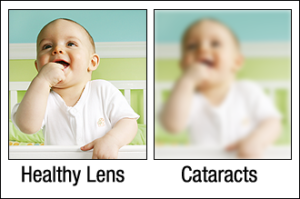Cataracts are one of the most common eye conditions that usually develop as a result of aging. Eventually, everyone will develop them at some point as they get older.
They affect almost half of all adults by age 75 and develop in many adults as early as the age of 40. If you’re over 40, you should be aware of your heightened risk for cataracts.
For this reason, see your eye doctor for regular eye exams. It’s not only to have your cataracts diagnosed early, but so your ophthalmologist can spot any early signs of other eye conditions.
You should also see your eye doctor if you start to develop cataract symptoms. Cataract symptoms may be hard to notice as they tend to develop slowly over a period of months or years.
It may even take decades before you realize you have cataracts! Oftentimes, you could have a cataract but no symptoms at first.
There are a few symptoms that are good indicators, especially if you exhibit several symptoms. Only your eye doctor can diagnose your cataracts.
Knowing these symptoms can help you know when you should seek diagnosis and treatment outside your regular eye exams. Keep reading to learn about some of the symptoms of having a cataract!
Blurry Vision

Cataracts happen when the eye’s usually clear natural lens becomes cloudy. This cloudiness can make objects appear blurrier, especially as the cataract develops.
Blurry vision can occur for many reasons, but with cataracts and some other age-related eye conditions, getting a stronger prescription for glasses or contacts won’t help. If you find your vision getting worse and glasses and reading glasses don’t have much of an effect, you could have cataracts.
Poor Night Vision
Another common symptom of cataracts is difficulty seeing in low light. Cataract patients often find it’s difficult to do tasks that need close focus like reading unless they have direct light.
Sometimes, this symptom can be mistaken for a decreased ability to focus up close, also known as presbyopia. Many cataract patients also have presbyopia, so you could have presbyopia and cataracts at the same time.
But if using direct lighting improves your ability to read or perform other close-up tasks, it’s likely that the issue is, at least in part, cataracts.
Light Sensitivity

Cataract patients also tend to be sensitive to light. This can be especially noticeable when driving at night. When you have cataracts, it becomes harder to see at night.
Oncoming traffic and street lights may make light sensitivity worse. The combination of having a hard time seeing the road and being blinded by headlights can make it difficult and dangerous to drive at night.
If you’re having trouble driving at night due to visual problems, you should see your eye doctor, as well as avoid driving after dark. Get a friend or family member to drive you where you need to go at night to keep yourself and others  safe.
safe.
Glare and Halos
Besides light sensitivity, cataracts can make lights appear to have halos and cause increased glare. Looking at lights, especially if you have more advanced cataracts, can be much more difficult because of this.
It also makes car headlights even more disorienting, even before it gets completely dark out. Having trouble with light or lack of light, in general, is a good indicator that you may have cataracts.
Trouble Seeing Contrast
Patients with cataracts often have trouble seeing the contrast between colors. Colors may appear muted or more yellowish.
This symptom can be difficult to notice since it happens so slowly over time. You may find it’s harder to see the difference between two similar colors or to spot objects against similarly colored backgrounds.
When colors seem less vibrant and more muted, it can be a sign that you have cataracts. When it’s paired with the other symptoms listed here, it’s a very likely sign that you have advanced cataracts that may need treatment.
Experiencing Double Vision in One Eye
Seeing double in one eye, also known as monocular double vision, can be a very early sign of cataracts. It’s important to note that this is different from seeing double in both eyes.
The difference is that you see several images of the same object even when you have one eye closed. If you see double only when both eyes are open, that may be an indicator of a neurological condition. See a doctor or a neurologist before consulting an eye doctor.
Cataract Treatment

The only way to treat cataracts is through cataract surgery, which removes your natural lens and replaces it with an artificial lens. The artificial lens is known as an intraocular lens (IOL). Find out which IOL is right for you through our free online IOL self-evaluation test!
Cataract surgery is an incredibly common procedure that many patients undergo. With few risks and complications, it restores your clear vision that cataracts stole from you.
Cataract surgeons only recommend having cataract surgery once your cataracts start to interfere with your quality of life. The reason for this is because cataracts develop so slowly, they may not need treatment right away.
But if they affect your vision to the point that you can no longer complete everyday activities (like driving at night), it’s time to consider cataract surgery. The procedure is the only way to completely restore any vision lost to cataracts.
It’s still best to have your cataracts diagnosed in the early stages so your ophthalmologist can monitor their progression. Knowing how your cataracts are progressing will also allow you to identify when they start to affect your vision.
Adults over the age of 40 should see an eye doctor at least once a year for a routine eye exam. Depending on your risk for cataracts and other eye conditions, you may even need an exam more than once a year.
Talk with your eye doctor about your risks for age-related eye conditions so they can tell you how often you need to have your eyes examined.
Recognize some of the above signs of cataracts? Schedule a cataract screening at Omaha Eye & Laser Institute in Omaha, NE, today!


